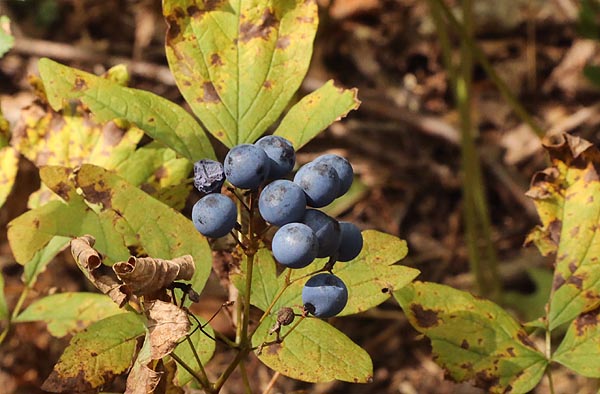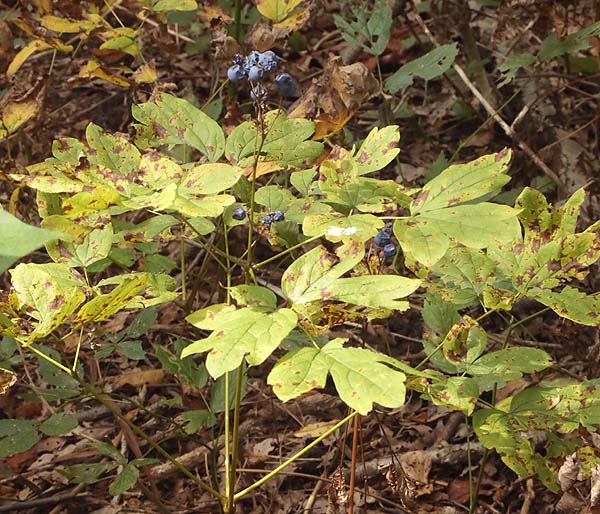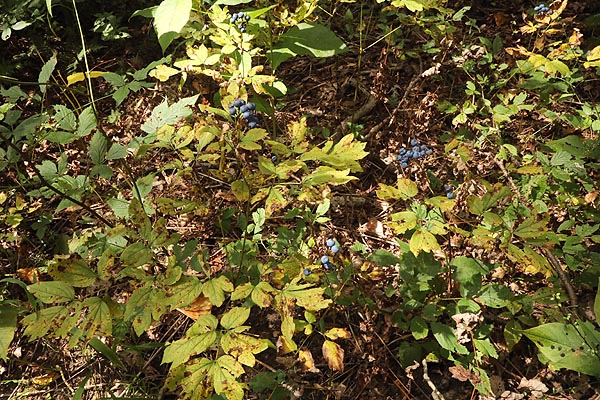Ideal plant for deep shady woodlands where it can form very effective ground cover. Growing Blue Cohosh will help to save it as over harvesting in the wild is sliding it towards the endangered list. Once established in deciduous woodlands it provides a lovely green understory with bright blue berries in the fall. Deer and rabbits don't eat the foliage or berries which can persist until spring. Spreading by rhizomes it can slowly form dense colonies and bring brightness to an otherwise bleak looking deciduous woodland. Helps to keep invasive species such as Japanese stiltgrass at bay. Best sown in place and left to grow as the seeds are picky about germinating and can take several years to establish. The results are worth it, and you help save a possibly endangered plant.
Description of Blue Cohosh (Caulophyllum thalictroides).
A Native American woodland perennial plant. It first appears in early spring with beautiful purple sometimes almost black shoots that change color as they grow to a smoky green. Young plants produce a single compound leaf at the top of the tall stem. More mature flowering plants produce a second leaf that arises from the middle of the first stem and is larger than the first. It's a plant of threes. Each complex leaf unusually has three sections and each of those sections have three subsections which support three ovalish leaflets which are usually lobed with points at the end of each lobe. Leaflets can vary in shape, some are mostly oval with a single pointed end, this is more common on the 'side' leaflets while the terminal one is usually tri lobed with points and larger than the other two. However they can all be the same tri lobed, or bi lobed and vary in shape and size. Since all this division of the leaf leads to 27 fairly large leaflets to the one leaf to the regular person (rather than a botanist) the plant appears to have many leaves arranged in busy appearance rather than just a single leaf that can reach 3 feet (91 cm) in height . Leaflets are a smokey green to grayish green which can be hard to define in shady woodlands.
From the center of the single leaf a single flower stalk will arising in mature plants. This stands above the leaf on a tall stem that supports a small cluster of tiny greenish flowers. Each flower is about ½ inch (1.2 cm) wide the most noticeable piece are the size sepals that are greenish purple in color. The actual petals are extremely small and nestled at the base of the sepals surrounding the stamens and ovary. Flowers occur on individual stalks in clusters from 5 to 30 and can easily be overlooked. The berries that follow the flowers however are much more noticeable due to their bright blue color. These are about 1/3" (0.76 cm) wide and round. The fruits start out green but turn blue by early fall and stay on the bush until the following spring offering bright colors even in winter. Blue Cohosh is not self fertile so several plants are required to obtain berries. Fruits are not often eaten by wildlife. Deer and rabbits rarely eat the foliage either. Plants establish a lumpy rhizome with thick offshoots as it matures.
Growing Blue Cohosh (Caulophyllum thalictroides) from Seed.
This is a tough seed to grow because its fussy about dormancy. Seeds need to be moist all the time. We keep our seeds with the berry to help keep them moist during storage. Blue Cohosh needs at least one cycle of cold before it will germinate some need two (cold warm cold) before they even consider breaking out. So with this one you need to be patient. There are two methods to follow.
Plant the seeds where you want them to grow, make sure the area does not dry out at any time. Seeding can be done at any time of year, although in fall might be best. If planting in spring or summer water the ground then cover it with a layer of mulch or dried leaves to keep the moisture into the ground. Water occasionally especially in hot dry periods of no rain. Remove some of the overlay after the winter period and check area occasionally making sure it does not dry out. If nothing germinates, cover again for winter and repeat the next year. Sometimes it can take three years before the seeds finally get the message and grow.
Sow in individual pots 2 inch (5cm) are ideal. Place pots in a cool area where there is shade. At all times ensure that the pots don't dry out. Under a bench, in a shady corner anywhere that you wont forget them and can check on them every once in a while and make sure they don't dry out. Remove any weeds that grow and leave until the seeds do germinate. Grow on to reasonable size before planting out in shaded location.
We do not recommend the refrigerator method for Blue Cohosh because they are so erratic direct sowing or outside pots are the best method.
Location and Care of Blue Cohosh (Caulophyllum thalictroides)
Does best in a rich woodland environment. Likes fairly dense shade under deciduous trees. Do not plant under coniferous trees (pines and fir) they will not grow. Ideal for woodland areas and areas of deep shade. If not planting in a woodland make sure you have plenty of organic material in the soil. In a woodland the fallen leaves are perfectly good mulch. Can take three years before they flower and fruit but its worth the wait. Will need several plants to get berries as they are not self fertile. Mature plants will spread slowly by rhizomes and will form small colonies if left alone. Deer don't eat Blue Cohosh so plants can form a very effective ground cover in deep shade areas. Will enhance any woodland and help to preserve a species heading for the endangered list.
Harvesting Blue Cohosh (Caulophyllum thalictroides)
The reason its endangered is because the roots are used in herbal medicine. Roots are dug in the early fall. If harvesting try to take only a small portion of the root and allow the plants to continue to grow and thrive.
Culinary Uses of Blue Cohosh (Caulophyllum thalictroides)
While it is claimed you can use the roasted seeds as a coffee substitute whoever said this either does not like coffee or does not remember what it tastes like. If desperate its drinkable but its not coffee. Since the seeds are not produced in large numbers this is a time consuming process.
Medical uses of Blue Cohosh (Caulophyllum thalictroides)
While Blue Cohosh is still used to by a few herbalists, most prefer to use other herbs as this one has been badly over harvested and may be sliding towards endangered. Thus ecologically minded herbalists prefer to use other plants if possible. Blue Cohosh has been used by North American Indian tribes to help facilitate childbirth with an infusion of the roots used a few weeks before labor to ease the birth, hence its common name Papoose root. Today herbalist consider this mainly as a herb to treat gynecological conditions as it is a uterine stimulant. Care should be taken using this in early pregnancy as it can induce miscarriage or stimulate early delivery. Non pregnant women have used it to suppress heavy menstrual flow, relieve cramps and some forms of edema.
The plant does have other uses and its antispasmodic and diuretic properties been used to treat rheumatism, epilepsy, colic, bronchitis, break fevers, suppress spasms, convulsions, and other nervous derangements.
This plant can be toxic and dosages are extremely important it should never be used without the supervision of a qualified and experienced herbalist.
Caution. While the root of this plant is used herbally the above ground portions especially the bright blue berries are very toxic. The contain methylcytisine, an alkaloid, as well as other glycosides that are poisonous. These compounds are reported to mimic the effects of nicotine bonding to the nicotinic receptors which can elevate the blood pressure stimulate respiration so causing shortness of breath, and can cause severe stomach pain. Children should be taught not to eat the berries.
Other names.
Papoose Root, Squaw Root, Blueberry Root, Blue Ginseng, Seneca Root, Squawroot, Yellow Ginseng








